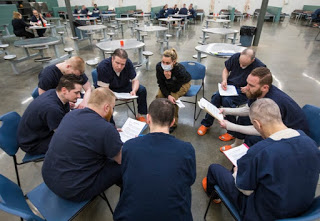
Photo: Liz Dufour/The Enquirer
—–
A jail in Northern Kentucky has embraced science-based research for inmates with addiction for inmates who want it since 2015, and now that program includes care after release, Terry DeMio
reports for the
Cincinnati Enquirer.
DeMio walks through what the Kenton County Detention Center in Independence offers inmates, while regularly reminding readers that while the program is not what standard incarceration looks like, “It is still a jail.”
“But it is rare for jails and prisons in the United States to offer a full continuum of treatment for inmates with addiction, and especially, to include medication – even though it is the standard of care,” she writes.
In 2015, the detention center hired Jason Merrick, a certified drug and alcohol addiction counselor with degrees in social work who was in recovery himself to a newly created role: addiction services director. Merrick designed the program around what addiction specialist consider best practices, DeMio reports.
In 2018, the jail partnered with Hazelden Betty Ford Foundation in a program called Strong Start Comprehensive Opioid Response with 12 Steps and Reentry, which includes three months of treatment that includes opioid-use disorder medications, followed by three months of aftercare.
DeMio reports that it appears to be working. Only 24% of those who completed both the jail and aftercare program have been rearrested and jailed after three years, said John Clancy, director of strategic partnerships at the Life Learning Center, a focal point of the aftercare program. That compares to 68% recidivism after three years nationally, according to the Department of Justice.
The program, which is voluntary, has evolved to include two deputy/counselors, two re-entry specialists, a population management specialist and three social-work interns from Northern Kentucky University.
The staff makeup is just what people with substance-use disorder need, says Lindsey Vuolo, vice president of health law and policy for the
Partnership to End Addiction, a national nonprofit dedicated to transforming how the United States addresses addiction.
“It is really important for jails and prisons to include medical professionals and individuals with lived experiences when designing this type of program,” Vuolo told DeMio, citing research from the National Council for Behavioral Health.
And all along, the University of Kentucky Center on Drug and Alcohol Research tracks and evaluates the Kenton County treatment plan, DeMio reports.
DeMio reports how the Life Learning Center in Covington, which offers the aftercare, helps the former inmates. She notes that it offers a range of services that include helping the former inmates connect with health care providers who offer medication assisted therapies to providing job-readiness skills and job-finding help.
She also notes that the center helps the former inmates find appropriate clothing for work, offers childcare, helps them find affordable dental care and offers an on-site location that will remove their tattoos for free.
DeMio also walks through how the program is funded and how officials say it ultimately saves taxpayers money.
She writes, “Here’s how: A year of incarceration costs about $24,000 for one person. Almost every inmate in the treatment program is spared a conviction likely to yield an 18-month jail sentence. The inmate is jailed instead for 90 days – which yields 15 months not served. That 15 months would cost $30,000 if served in jail. Merrick’s records show that about 450 graduates have gone through women’s and men’s programs each year. That’s $13.5 million saved every year, he says. Beyond that: Without evidence-based treatment in jail, it’s likely
inmates with opioid use disorder will relapse after release. And if they don’t overdose and die, it’s likely they’ll be arrested again and return for more jail stays.”
For Bethany Ball, associate director of Addiction Services, and her staff, it’s not just about the dollars, DeMio reports.
“We are trying to address the areas that we see people struggling with consistently, especially those that aren’t always addressed: culture, mental health, trauma, childhood trauma,” Ball told DeMio. “We are committed to not just saving lives, but helping to show that there is a life worth living and they are worthy of that life.”
